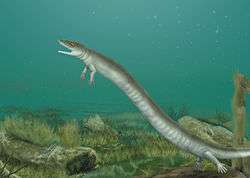Recumbirostra
| Recumbirostra Temporal range: Late Carboniferous - Early Permian | |
|---|---|
 | |
| Life restoration of the recumbirostran Micraroter erythrogeios | |
| Scientific classification | |
| Kingdom: | Animalia |
| Phylum: | Chordata |
| Subclass: | †Lepospondyli |
| Order: | †"Microsauria" |
| Suborder: | †Tuditanomorpha |
| Clade: | †Recumbirostra Anderson, 2007 |
Recumbirostra is a clade of lepospondyl amphibians from the Carboniferous and Permian that includes the families Pantylidae, Gymnarthridae, Ostodolepidae, Goniorhynchidae, Brachystelechidae, and Microbrachidae.[1] Recumbirostra was erected as a clade in 2007. It includes many lepospondyls traditionally grouped in "Microsauria", which has since been shown to be a paraphyletic grouping.[2][3] Not all phylogenetic analyses recognize Recumbirostra as a valid grouping. An alternative clade called Tuditanomorpha is occasionally supported and includes many of the same taxa.[4] Below is a cladogram showing the phylogenetic relationships of recumbirostrans from Glienke (2012):[1]
| Recumbirostra |
| ||||||||||||||||||||||||||||||||||||||||||||||||||||||||||||||||||||||||||||||||||||||||||||||||||||||
| |
Most authors consider recumbirostrans to be lepospondyl amphibians; however, a phylogenetic analysis conducted by Pardo, Szostakiwskyj and Anderson (2015) recovered them as sauropsid amniotes instead.[5]
References
- 1 2 Glienke, S. (2012). "A new "microsaur" (Amphibia; Lepospondyli) from the Rotliegend of the Saar–Palatinate region (Carboniferous/Permian transition; West Germany)". Paläontologische Zeitschrift. doi:10.1007/s12542-012-0130-8.
- ↑ Anderson, J.S. (2007). "Incorporating ontogeny into the matrix: A phylogenetic evaluation of developmental evidence for the origin of modern Amphibians". In Anderson, J.S.; and Sues, H.-D. (eds.). Major Transitions in Vertebrate Evolution. Bloomington and Indianapolis: Indiana University Press. pp. 182–227.
- ↑ Huttenlocker, A. K.; Pardo, J. D.; Small, B. J.; Anderson, J. S. (2013). "Cranial morphology of recumbirostrans (Lepospondyli) from the Permian of Kansas and Nebraska, and early morphological evolution inferred by micro-computed tomography". Journal of Vertebrate Paleontology 33 (3): 540.
- ↑ Henrici, A.C.; Martens, T.; Berman, D.S.; Sumida, S.S. (2011). "An ostodolepid 'microsaur' (Lepospondyli) from the Lower Permian Tambach Formation of central Germany". Journal of Vertebrate Paleontology. 31 (5): 997–1004. doi:10.1080/02724634.2011.596601.
- ↑ Jason D. Pardo, Matt Szostakiwskyj and Jason S. Anderson (2015). "Phylogenetic relationships of recumbirostran 'lepospondyls' inferred from neurocranial morphology". Society of Vertebrate Paleontology 75th Annual Meeting Program & Abstracts: 191.